Cláudio Santoro National Theater

The Cláudio Santoro National Theater (Teatro Nacional Cláudio Santoro) is a multi-theater building in Brasília, Brazil. It was designed by Oscar Niemeyer in the Modern architectural style. Construction began on July 30, 1960, and the building was completed in 1966. Built in the shape of a truncated pyramid, it is the largest building in Brasilia designed by Niemeyer specifically for the arts. The building was closed for renovation in 1976, and was reopened on April 21, 1981. The National Theater is operated by Secretary of Culture of the Federal District and is home to three venues; the 60-seat Alberto Nepomuceno theater, the 407-seat Martins Pena theater, and the 1,407 seat Villa-Lobos theater. The complex also includes an exhibition gallery that is accessible to the public.The Theater has been under renovation for more than two years and remains closed to the public.
Excerpt from the Wikipedia article Cláudio Santoro National Theater (License: CC BY-SA 3.0, Authors, Images).Cláudio Santoro National Theater
Eixo L Norte, Brasília
Geographical coordinates (GPS) Address External links Nearby Places Show on map
Geographical coordinates (GPS)
| Latitude | Longitude |
|---|---|
| N -15.7922 ° | E -47.8802 ° |
Address
Teatro Nacional Cláudio Santoro
Eixo L Norte
70002-900 Brasília
Federal District, Brazil
Open on Google Maps







